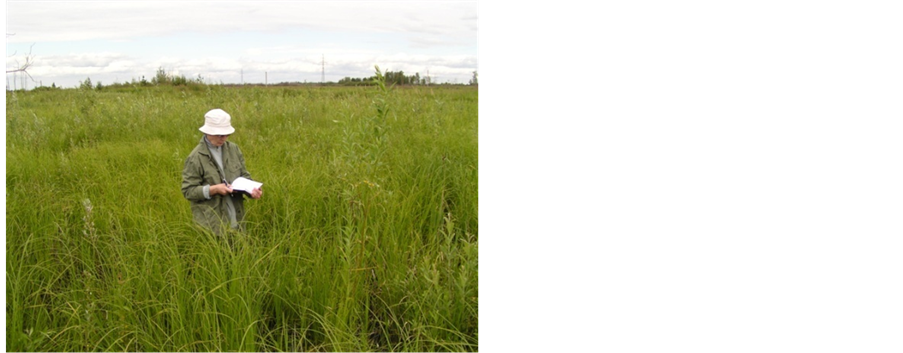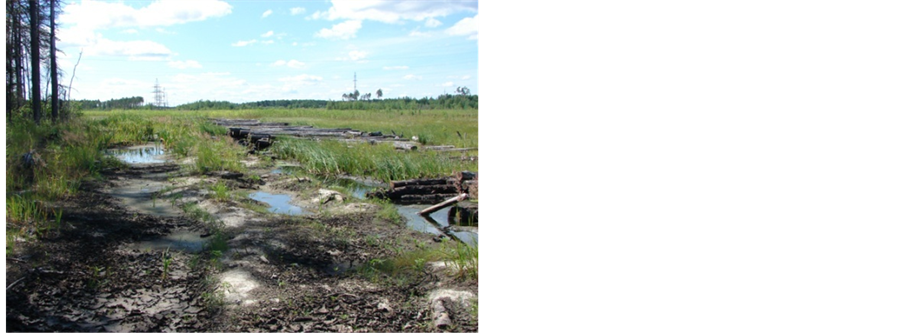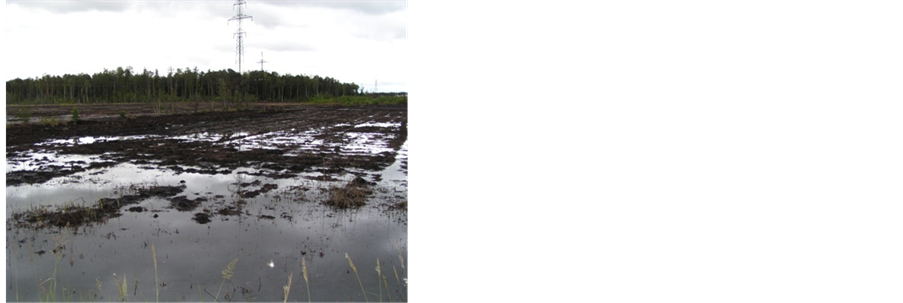Natural Resources
Vol.5 No.1(2014), Article ID:41841,4 pages DOI:10.4236/nr.2014.51001
Post Remediation Succession of Oil-Contaminated Landscapes of Taiga in West Siberia
![]()
Surgut State University, Surgut, Russian.
Email: landscape-ecology@yandex.ru
Received October 5th, 2013; revised November 1st, 2013; accepted December 22nd, 2013
ABSTRACT
This paper presents the results of the 10-years observations for the restoration of soil-vegetation cover of oil polluted taiga landscapes of Western Siberia after remediation. The author analyses some indicators of physical and chemical composition, properties of soils, the changes in species composition and correlation of ecological and biomorphological groups of species, and evaluates the changes in plant community methods of ecological bioindication. There has been revealed the influence on the direction of successional changes in environmental factors such as the situation in the macro-and-mesorelief, properties of soil and the composition of the original vegetation. There is an active oil-and-salt spread of contaminants in the soil adjacent parcels and their progressive eutrophication.
Keywords:Oil-and-Soil Contamination; Remediation; Vegetation; Soil; Dynamics
1. Introduction
The increasing amounts of accidental releases of oil and petroleum products into the environment lead to a fundamental breach of the life conditions of all organisms. Oil is a complex of chemical compounds that have diverse negative impacts on all components of nature when releasing into the landscapes. In severe bioclimatic conditions of the taiga zone of Western Siberia, oil biodegradation and processes of washing-out minerals occur very slowly, which is why the recovery of initial biogeocenosis is delayed for a long time. However, the use of remediation (restoration) measures to speed up these processes is not always successful.
Such global problems of the vast area of oil production in the center of Western Siberia have led to the need to study the processes of restoration of disturbed lands with the help of Geo and soil science methods.
1.1. The Aim of the Research
To study the character and the rate of the soils and vegetation properties under the influence of oil cotaminants.
To analyze the dynamics of soil and vegetation recovery on the oil-contaminated areas after the restoration activities.
1.2. Targets of the Research
1) To describe the analytical material on the alterations in the salts and petroleum content of oil-contaminated soils within the years of 2003-2010.
2) To characterize the dynamics of specific, bio-morphological and ecological composition of phytocenosis after the restoration activities.
3) To perform the environmental assessment of vegetation habitats restoration with the help of bioindication environmental scales and to consider the biological and soil analytical data relationship.
4) To assess the impact of oil polluted landscapes on to the adjacent areas.
2. Materials and Methods
The studies were conducted in 2003-2010 on the oilcontaminated areas of the two oil fields located within the floodplain bench complex of the Middle Ob valley. One site is an independent array of floodplain in the Yuganskaya Ob, the other one, located on the second terrace above the floodplain of the Ob, is the slope of mane to the peripheral transitional marsh and the contaminated masif of the marshes.
In the areas which underwent the remediation, permanent plots were laid to study the dynamics of vegetation, soil properties and its modes. The system of soil remediation to enhance microbial processes included the application of mineral fertilizers and forced aeration of the soil. On the trial sites located on the geochemical catena within each region, geobotanic descriptions of vegetation were held annually and soil samples were collected to determine their content of salts and petroleum [1]. The analyses where performed in the accredited laboratories.
While assessing the habitats according to the bioindication environmental scales by L.G. Ramenskii, two factors were considered: moisture (M) and active wealth and soil salinization (WS). Thus, the vegetation acted as the object of the observation, and as the indicator of the environmental conditions of habitats.
3. Results and Discussion
As the bioindicator assessment of vegetation, oil pollution of soils with the subsequent rekultivation on various litologo-morphological formations showed (the flood plain, terraces) sharp changes over time the general ecological conditions of the sites. On the above the flood plains terraces above the flood plain mezooligotrofics and mesotrophics habitats forests and bogs are followed by rich-mezoeutrofny. When contaminating floodplain communities, the habitat type is saved (mezoeutrophics conditions) as the entire floodplain vegetation completely corresponds to these conditions of environmental requirements. Thus, after the oil pollution and land reclamation activities, the initial environmental diversity of floodplain and terraced plots is smoothed; they all now belong to the category of wet or marshy mezoeutrophic habitats [2].
After the upper layers of the soil reduce the toxicity, plants are settled. Successional vegetation on oil-contaminated sites is changing in the direction of young weed species being substituted by perennial native species, and eutrophics species by mezoeutrophics and mesotrophics species. Whithin the time, this process stabilizes and slows down and the formation of the closed sward begins.
Revegetation of the soil cover happens in correspandence with the original terms of habitats and due to water-loving species of native flora, such as bulrushes, broadleaf cattail, cane, sedges, cotton grass, reed, water plantain. The crops of the so-called grass-“ameliorantors” (timothy grass, fescue, brome) on the bog peat soils are ineffective. These species are unstable and fall out in all cases of herbage during the second year after planting. Thus “phytorecultivation” as a method of soil remediation is absolutely useless. Furthermore, to indicate the degree of soil toxicity cheaper oats can be used.
The recovery rate of vegetation on reclaimed areas depends on the degree of contamination, morphological and genetic features of the site (macroforms of the relieffloodplain, floodplain terraces, mesoforms-increases, decreases) as well as the presence of hydrophilic species of meadow-marsh flora in the source and the neighboring communities.More rapid return to the original state of vegetation is only possible on floodplain lands because floodplain flora species are adapted to living in conditions of rich nourishing, high humidity and lack of oxygen in the soil [2]. Thus, flood areas herbage is formed within 4 - 5 years, despite the fact that the soil still contains significant concentrations of salts and oil (Picture 1). There is no doubt that there are also affects of flood
irrigation of soils by flood waters, which agrees with the opinion of other authors.
On the above flood terraces the recovery process of mezooligotrophic and oligotrophic forest and wetland communities takes much longer because the indigenous vegetation is dominated by species of plants which avoid rich and saline soils. The formation of the original vegetation is possible only after reducing the amounts of pollutants in the soil. The higher the degree of soil contamination by salts and, to a lesser extent, by oil products, the less fast recovery of the original vegetation in terraced plots is. For successful revegetation it is necessary to ensure the settlement of such areas with moisture-loving meso-and eutrophics species of herbaceous plants (reeds, cattails, train, sedges, rushes, willow), which correspond mezoeutrophics habitat types.
Studies on soil catena showed that regardless of the pollution source location (mezoincrease or decrease) there is a “spread” of pollutants to adjacent areas [2]. This fact was noted earlier by N.P. Solntsevoy [3]. Accordingly, there is observed a degradation of forest and shrub vegetation, moss cover in forests, having developed higher on sloping surfaces adjacent to the oil-contaminated sites, due to the increase in the content of salts and petroleum products in the upper layers of the soil of these sites. In the “core” of the pollution and the lower parts of the slopes, there is a complete destruction of the vegetation cover (Picture 2), The projective cover of moss decreases, the cover of herbs and shrubs is growing, in the vegetation cover in the middle of the slopes and these changes are less noticeable in the upper slopes of the ground cover.
Within the time, after land reclamation activities, the content of mineral salts in the wetlands soil is reduced, however, the disturbed vegetation cover does not recover as quickly as insoluble products of oil degradation remain in the ground for a long time (Picture 3).
The 10-year-study of the dynamics of ecological composition of plant communities in floodplain and terraced areas found that together with the decrease of soil fertility of the habitats there is an increase in the hydrophilicity of plant communities, not only in the reclaimed areas, but also in the neighboring ones. On the floodplain area it is shown by increasing water cut and also an increase in the participation of these hydrophytes. On the terraced area, the habitat “swamping” is well revealed by the environmental composition of plant communities on sloping surfaces adjacent to oil-contaminated areas, where there is also an increase in the content of a water-loving species.
This clearly expressed tendency of hydrophytization of vegetation species composition and even of elevated platforms of catena located outside the pollution core is undoubtedly due to the increase in total hydromorphics of soil due to the accumulation in soils of heavy bitumen
and pores clogging. This leads to a deterioration of soil aeration and increases effects of anaerobiosis in the soil mass [4].
4. Conclusions
Thus, long-term research of the taiga zone of Western Siberia contaminated by oil showed the following:
1) Vegetation cover of the pollution core and adjacent landscape undergoes a significant change related to the change in the properties and composition of the soil.
2) There is an increase of oil products and salts in the upper soil horizons in the areas which neighbor with oilcontaminated sites, even on higher positions of slopes of ridges, where degradation of vegetation is detected.
3) There is a gradual environmental change in the vegetation, indicating the progression of “swamping”—
improvement of soil fertility and moisture of habitats adjacent to the oil-contaminated areas.
4) For successful remediation of contaminated lands and revegetation, the following factors are important: the situation in the macro-and mesorelief, the nature of soils, the composition of initial plant communities and the concentration of pollutants.
REFERENCES
- A. I. Shepelev, L. F. Shepeleva, V. N. Frolov and R. G. Mazitov, “On the Methodology of Environmental Monitoring of Oil-Contaminated Lands in the Taiga Zone of Western Siberia. Monitoring of the Environment, Geo, Remote Methods of Earth Sensing: Compilation of Works from Scientific Congress ‘Geo-Siberia-2005’,” SGGA, Novosibirsk, 2005, pp. 129-133.
- L. F. Shepeleva, “Revegetation of Oil-Contaminated Lands of Middle Ob after Reclamation,” Bulletin of Tomsk State University, Tomsk, No. 299, 2007, pp. 222-227.
- N. P. Solntseva, “Oil Extraction and Geochemistry of Natural Landscapes,” Moscow State University Press, Moscow, 1998, 376 p.
- A. I. Shepelev, “Reactions of Ob floodplain Soil on Oil-And Salt-Contamination (Dynamics of Composition and Properties of Soils, Intermediate Outcomes)/Reflection of Bio-, Geo, Antropospheric Interactions in Soils and Land Cover: Materials from IV All-Russian Scientific-Practical Conference with International Participation,” Tomsk, 2010, pp. 235-238.


 (a)
(a)  (b)
(b)  (a)
(a)  (b)
(b)  (a)
(a)  (b)
(b)